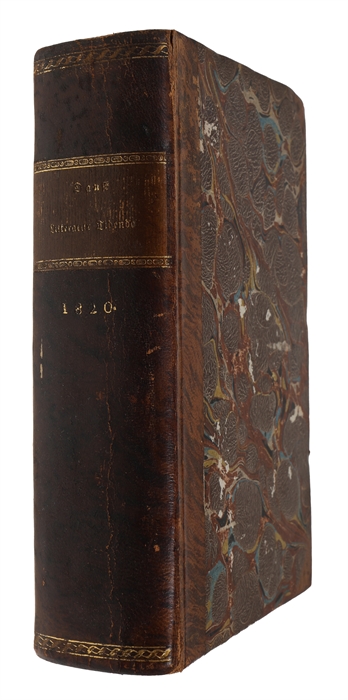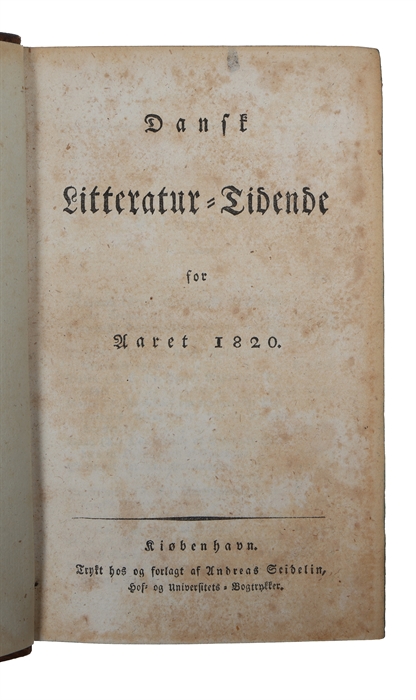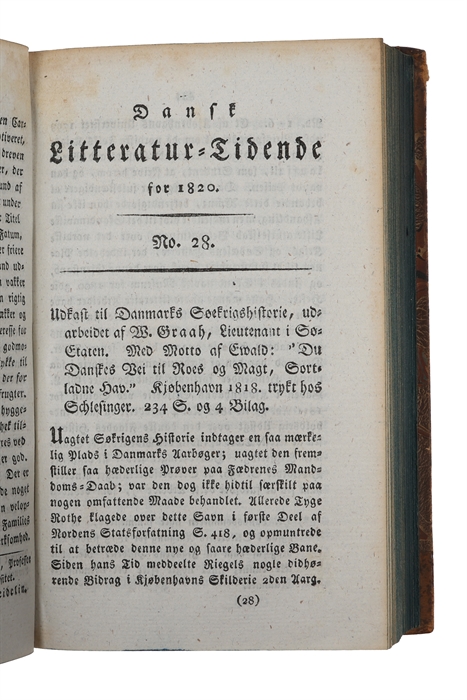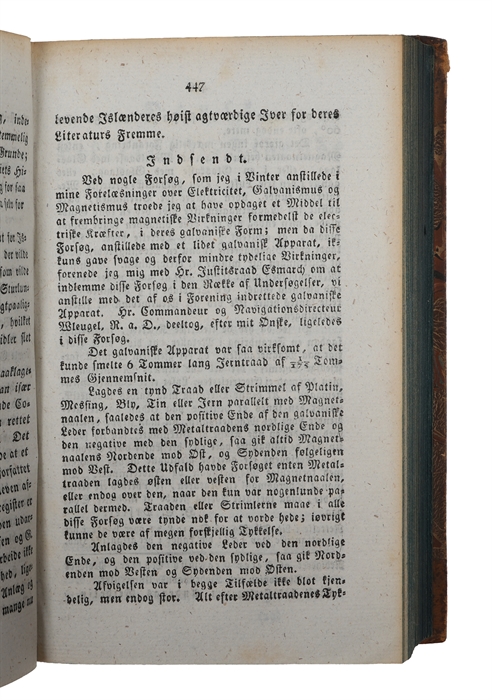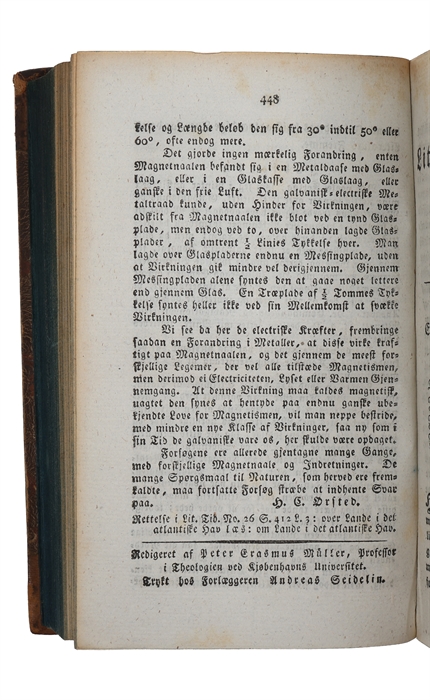THE VERY FIRST ANNOUNCEMENT OF THE DISCOVERY OF ELECTROMAGNETISM
(ØRSTED, H. C. (OERSTED)).
Indsendt. Ved nogle Forsøg, som jeg i Vinter anstillede i mine Forelæsninger over Electricitet, Galvanismus og Magnetismus ....Lagdes en tynd Traad eller Strimmel af Platin, Messing, Bly, Tin eller Jern parallelt med Magnetnaalen... H.C. Ørsted. (i. e. English: "Submitted. By some Experiments as was made by me last Vinter while lecturing on Electricity, Galvanism, and Magnetism....There was laid a thin wire or strip of Platinum, Brass, Lead, Pewter or Iron parallel to the magnetic Needle....H.C. Ørsted").
Kiøbenhavn, Andreas Seidelin, 1820.
8vo. In contemporary brown half calf with lighter brown leather title-label with gilt lettering. All edges coloured in blue. In: "Dansk Litteratur = Tidende for Aaret 1820". (The entire volume 1820 present, comprising all 52 issues, numbered 1-52). Light wear to extremities, spine with a few scratches. With occassional brownspotting, primarily affecting first and last leaves, but generally nice and clean. (Entire volume:) X, 822 pp. (Oersteds paper's in issue no. 28:) pp. 447-448.
The exceedingly rare very first announcement of H. C. Ørsted’s landmark discovery of electromagnetism, predating his famous “Experimenta”-paper by at least a week. Publishing the present brief note allowed him to quickly claim priority for his discovery, which ensured that his work would be recognized and attributed to him before others potentially stole his discovery. The offered paper was published in the 28th week of July, 1820 (No. 28 of the periodical), which means that it was published some time between July 11 and July 16, probably the 11th or 12th. The paper which made Oersted famous all over Europe was his Latin pamphlet "Experimenta circa effectum conflictus electrici in acun magneticam. Hafniæ, 1820", dated July 21, 1820. The Latin “Experimenta” was sent on the same day (according to Kirstine Meyer in "Scientific Life and Works of H.C. Ørsted") to learned bodies and scholars in all European countries. The communication offered here (in Danish) was published at least a week before "Experimenta". The essence of Oersted's discovery is detailed in the paper offered here, where he describes how the magnetic effect of an electric current-carrying wire was initially observed using an incandescent platinum wire. He then extended his experiments to non-incandescent wires made from various materials noting that the magnetic effect was influenced by the wire's dimensions. Among Oersted's papers (now in the holding of the Danish Royal Library), we have both a draft written in his own hand on acid-stained paper and a nearly identical version in another handwriting. These experimental notes form the basis of the present paper (which Kirstine Meyer refers to as "Supplement II"). In Supplements III and IV (dated July 15 and 21), Oersted further elaborates on his experiments with the wire in different positions relative to the magnet which became his “Experimenta”-paper. “Electromagnetism itself was discovered in the year 1820, by Professor Hans Christian Oersted, of the University of Copenhagen. Throughout his literary career, he adhered to the opinion, that the magnetical effects are produced by the same powers as the electrical. He was not so much led to this, by the reasons commonly alleged for this opinion, as by the philosophical principle, that all phenomena are produced by the same original power. … His researches upon this subject, were still fruitless, until the year 1820. “We have now reached the spring of 1820. Ørsted understood that the “feeble” disturbance of the compass needle seen in his lecture demonstration was a genuinely important discovery. Other duties prevented a more detailed and quantitative investigation of this effect until the beginning of July 1820. Ørsted had new laboratory facilities and a more powerful galvanic apparatus that facilitated his measurements. Confident that his experiments would have a successful outcome, he gathered a group of six distinguished observers who would serve as witnesses of his experiments. (Their names and credentials were duly noted in the written description of his investigations.) He set about an exhaustive series of measurements aimed at documenting how the distance and orientation of a current-carrying wire affected the deflection of a compass needle. He made copious notes and drawings, many of which can be seen in Det Kongelige Bibliotek in Copenhagen. ” (Karen Jelved & Andrew D. Jackson, H. C. Ørsted and the Discovery of Electromagnetism, 2019). But before the above mentioned Latin paper was published - which within the same year was reprinted in England, France, Germany and Italy - Oersted made sure to secure his discovery and consequently eternal fame by publishing the present paper.
The importance of the discovery of electromagnetism, one of the most pivotal moments in the history of science, can hardly be overestimated. Here, Ørsted laid both the theoretical and practical foundation for future works of Faraday, Maxwell, and Hertz.
In the winter of 1819–20, he delivered a course of lectures upon electricity, galvanism, and magnetism, before an audience that had been previously acquainted with the principles of natural philosophy. In composing the lecture, in which he was to treat of the analogy between electricity and magnetism, he conjectured, that if it were possible to produce any magnetical effect by electricity, this could not be in the direction of the current, since this had been so often tried in vain, but that it must be produced by a lateral action.
This was strictly connected with his other ideas; for he did not consider the transmission of electricity through a conductor as an uniform stream, but as a succession of interruptions and reestablishments of equilibrium, in such a manner that the electrical powers in the current were not in quiet equilibrium, but in a state of continual conflict.… The plan of the first experiment was to make the current of a little galvanic trough apparatus, commonly used in his lectures, pass through a very thin platina wire, which was placed over a compass covered with glass.
The preparations for the experiments were made, but some accident having hindered him from trying it before the lecture, he intended to defer it to another opportunity; yet during the lecture, the probability of its success appeared stronger, so that he made the first experiment in the presence of the audience. The magnetical needle, though included in a box, was disturbed; but as the effect was very feeble, and must, before its law was discovered, seem very irregular, the experiment made no strong impression on the audience [“Thermo-electricity,” in Edinburgh Encyclopaedia (1830), XVIII, 573–589; repr. in Oersted’s Scientific Papers, II, 356].
OCLC only list three copies (Danish Royal Library, Houghton, Harvard, USA & British Library).
Bibliotheca Danica IV: 535 (The periodical was published from 1811-36).
Erslew "Almindeligt Forfatterlexicon", Bd. III, p. 688.
(Dibner 61, PMM 282, Horblitt 3 b, Sparrow 152, Norman 1606 - all 4 only recording the later "Experimenta").
Order-nr.: 61598

